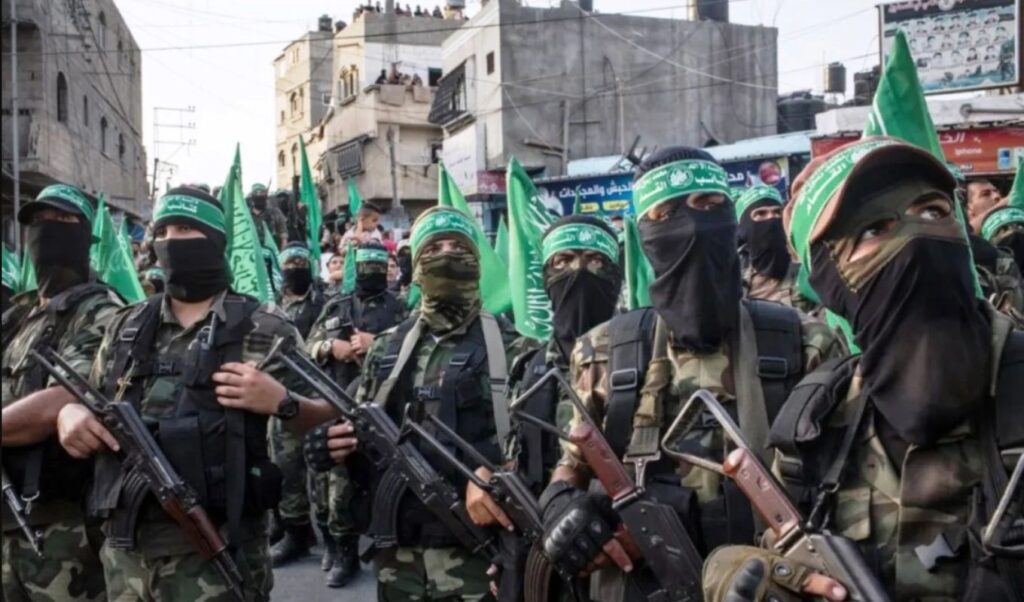While it may have publicly presented a united front and accepted key points of Donald Trump’s Gaza plan, Hamas is deeply divided on how to proceed, according to a Wall Street Journal report. On Friday, the terrorist organization designated as such by the US stated it was willing to release hostages and hand over Gaza, in a historic statement that bolsters Trump’s effort to end the war. However, Hamas used ambiguous language that some analysts considered problematic for achieving lasting peace.
Read: Gaza: What Trump’s announcement brings – The “thorns” in the Israel & Hamas agreement (Video)
Hamas division: Two lines inside and outside Gaza – What’s being discussed about disarmament
A major reason, the WSJ emphasizes, is that Hamas has not reached consensus on disarmament and the terms under which hostages would be released, according to Arab officials from countries mediating with Hamas. These are the two most important conditions of Trump’s plan.
Khalil Al-Hayya, a senior Hamas negotiator, and several other senior officials support accepting the proposal despite significant reservations, according to Arab mediators. However, these Hamas officials, who are located outside Gaza, have limited influence over the organization’s armed wing, which remains in Gaza.
Ezzedin al-Haddad, who assumed Hamas leadership in Gaza after Israel’s assassination of Yahya and Mohammed Sinwar, told mediators he is open to compromises. Mediators reported that Haddad is willing to hand over missiles and other weapons to Egypt and the United Nations for storage, but wishes to retain small arms like rifles, which Hamas considers defensive.
However, Hamas commanders in Gaza fear they won’t be able to enforce fighter compliance with demilitarization terms if they accept an agreement that amounts to surrender, mediators reported. The organization has recruited many young men since the war began, often those who have seen their homes destroyed or family members killed. These fighters may not be willing to surrender their weapons.
The most contentious points of the plan are the requirements for Hamas to disarm, surrender its weapons, and release the 48 Israeli hostages it continues to hold — alive and dead — within 72 hours of an agreement.
Voices within Hamas calling it a “72-hour ceasefire”
Critics within Hamas characterize the proposal as a “72-hour ceasefire” rather than a genuine peace agreement, reflecting their lack of trust in Israel. Hamas stated Friday that it desires further “negotiations to discuss details,” which appear to include hostage releases.
Trump expressed confidence that Hamas “is ready for lasting peace.” He called on Israel to “immediately stop bombing Gaza” to ensure safe conditions for hostage releases. His statement reflected White House confidence that Hamas had accepted the American president’s plan.
However, Hamas military leaders insisted that any hostage release must be linked to a clear timeline for Israeli withdrawal from Gaza, according to mediators.
Israel may be reluctant to end hostilities, as Hamas made no mention of disarmament in its statement and set significant conditions for hostage releases.
On X, Republican Senator Lindsey Graham called Hamas’s response “unfortunately predictable. The classic ‘Yes, but…'” “No demilitarization, maintaining Gaza under Palestinian control, and linking hostage releases to negotiations, along with other problems,” Graham said. “This is, essentially, a rejection by Hamas of President Trump’s proposal.”
Israeli Prime Minister Benjamin Netanyahu responded cautiously to Hamas’s statement, saying Israel would begin preparations for releasing hostages held in Gaza and would work with Trump to end the war — on Israel’s and the American president’s terms.
The Israeli military did not specifically commit to stopping attacks but said it would adopt a more defensive stance, stating it would prepare for hostage releases and respond quickly to any threats.
Some analysts noted that Hamas’s statement aimed to buy time for the organization to resolve longstanding tensions between its political and military wings. Disagreements over strategy have plagued Hamas throughout its war with Israel, which began with Hamas’s deadly attacks on southern Israel and the kidnapping of approximately 250 hostages nearly two years ago.
On the battlefield, Hamas has suffered major losses but continues fighting. Its armed wing has lost most of its senior leadership and thousands of experienced fighters. Many new recruits lack adequate training, while Israel’s strict surveillance of Gaza has limited the organization’s ability to coordinate operations.
To adapt, Hamas has delegated command to smaller units, according to Arab mediators and Israeli military officials. These units often operate independently, making their own decisions about when and how to attack Israeli forces.
According to the WSJ, Israeli military officials report that Hamas has not abandoned the fight. They believe the organization’s command and control has collapsed, with small groups operating independently through guerrilla warfare, primarily using explosives and snipers.
Haddad and other senior leaders exercise limited control over these units, a problem exacerbated by financial crisis that has restricted Hamas’s ability to pay salaries. The WSJ previously reported that lack of funds weakens Hamas’s influence.
Israel has captured large sections of Gaza City since beginning its offensive in mid-September. Many Hamas fighters have already retreated south and most civilians have evacuated the area. Israel’s basic dilemma is what to do if it captures Gaza City and Hamas refuses to surrender.
Thousands of Hamas fighters remain in Gaza City, according to a senior Israeli military official. These forces continuously monitor Israeli troops and seek vulnerable points, the official added. Two weeks ago, the same official added, a commander was killed by rocket fire. The Israeli official described Hamas’s remaining forces as mostly young and inexperienced, but still determined to fight. Surrenders are rare and usually occur only when fighters are surrounded, the official said.
“This is why negotiations are becoming reality. Perhaps, it’s the first time throughout the war that Hamas is beginning to understand it will be eliminated,” said Amir Avivi, former senior Israeli Defense Ministry official.
Several fighters open to defecting from Hamas
Mediators warn that if Hamas leaders accept Trump’s plan, some fighters may defect and join other Palestinian militant groups. Many have already threatened to join factions like Palestinian Islamic Jihad or the Palestinian Liberation Front. Coordination between these groups has largely collapsed, creating uncertainty about whether an agreement with Hamas alone could stop the fighting.
Qatar, Egypt, and Turkey attempted to pressure Hamas leaders, warning them this is their last chance to end the Gaza war, according to Arab officials. They told Hamas that if it rejects the agreement, they can no longer continue providing political or diplomatic support, officials reported according to the WSJ.
In his social media post, Trump stated: “We are already in discussions about the details that need to be worked out. This is not just about Gaza, but about the much-desired PEACE in the Middle East.”




